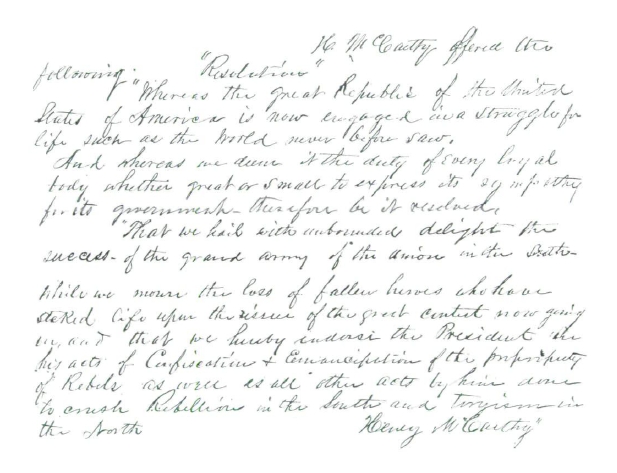
Mr. Wilcox is a graduate student and teaching assistant in American History at Iowa State University, Ames, Iowa. In these capacities and as the assistant to the director of the Department of Special Collections at the Iowa State Library, he has developed an interest in relating local Iowa history to the history of the United States. As a result, he has edited the document below to give relevance to what might otherwise have remained a forgotten example of Iowa's Civil War past.
The territorial government of Iowa first established county boards of supervisors in 1838. Compared to today, the county boards assumed much more jurisdictional power but in fewer areas of government. They literally governed the counties, levying taxes and conducting all county business, but primarily, focusing on matters concerning their local communities.1
One reason why Story Gounty's Givil War resolution generates interest is because it deals with none of the responsibilities just mentioned. Surrounded by figures concerning property values and salary allocations, this "Resolution" focuses on the problems of the Givil War and the Nation. Found in the Auditor's Office2 of the Story County Courthouse, this document exemplifies the patriotism that Iowans felt during one of the most exciting periods in American history. In this, the first of thirteen volumes of the Supervisor's Minute Book, dated from January 7, 1861 to June 8, 1868, are the lines directed to the people of Story County.
January 10, 1863
H. McCarthy" offered the following "Resolution""Whereas the great Republic of the United States of America is now engaged in a struggle for life such as the world never before saw,
And whereas we deem it the duty of every loyal body whether great or small to express its sympathy for its government therefore be it resolved,"That we hail with unbounded delight the success of the grand army of the Union in the South
While we mourn the loss of fallen heroes who have staked life upon the issue of the great contest now going on, and that we hereby endorse the President for his acts of Confiscation & Emancipation of the property of Rebels as well as all other acts by him done to crush Rebellion in tbe South and toryism in the North
Henry McCarthy"
1All the information in this first paragraph was obtained in an interview with the Story County Auditor, Mrs. Dorothy T. Elliot on February 2, 1971.
2Records of the Board are kept in the Auditor's Office hecause the County Auditor is also the Clerk of the Board of Supervisors.
3Henry McCarthy is identified on page 152 of the Minute Book as Cbairman of the Board's Finance Committee. Sworn into office only five days prior to the presentation of this resolution, McCarthy represented Washington township—a township which presently lies southeast of the Iowa University campus.
With respect to Iowa history, not much has been written about Henry McCarthy. His life and noteworthy contributions to Story County have generally been overshadowed by his younger brother, Daniel McCarthy. Nevertheless, in an article written by Earle D. Ross in the Centennial Addition of the Ames Daily Tribune (September 5, 1964), McCarthy was said to have been an avid promoter of the small agricultural college located in Ames. In fact, he sold much of his own land at a reduced price as his contribution to the college that would become Iowa Stute University.
4Perhaps this phrase, "the duty of every loyal body whether great or small," provides the supervisor's justification for side-stepping their regular duties and endorsing the policies of the Union.
5During the seven months preceding this resolution, the Union armies defeated the Southern forces at Shiloh (April 6-7, 1862), at Perryville, Kentucky (October 8, 1862), and in the battle of Murfreesboro on Stone River (Deeember 31, 1862 through January 3, 1863).
6MeCarthy is probably referring to the two acts of confiscation passed in August of 1861 and July of 1862. The first federal confiscation acts authorized seizure of all property, iucluding slaves, being used in the rebellion. The second aet. in addition to providing special punishment for persons convicted of treason in the rebellion and providing for confiscation of property, other than slaves, gave freedom to all whose masters were aiding the Confederacy.
7The Emancipation Proclamation, issued by President Lincoln in September of 1862, gave Southerners the alternative of ceasing their rebellion by January 1, 1863 or to suffer economic loss through the freeing oF their slaves.
8Slaves, at this time, were regarded as property. The Dred Scott decision, issued March 7, 1857, legally supported this idea by stating that a slave, whether living in a slave state or a free state, was the property of his owner.
9According to Mitford Mathews' A Dictionary of Americanisms on Historical Principles, a tory is "a person regarded as disloyal; ua traitor." Therefore, "toryism in the North" refers to the Northerners disloyal to the Union. This term is somewhat confusing in that there were more popular words used during the Civil War to identify Southern sympathizing Northerners, such as "Copperheads" and "Doughfaces".